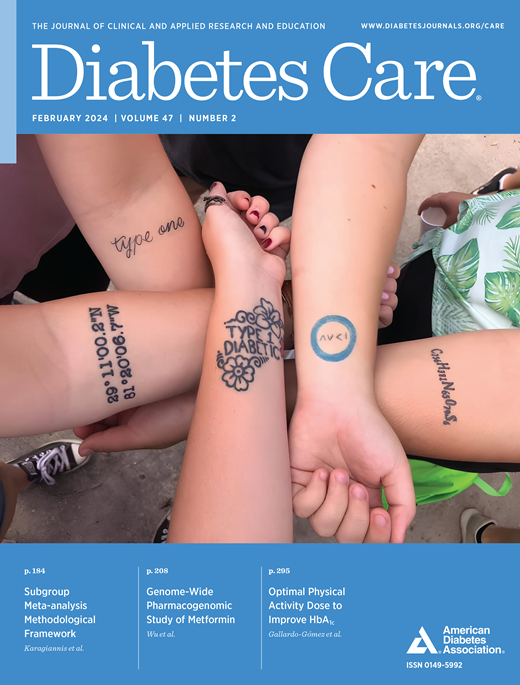达格列净单独或联合艾塞那肽治疗2型糖尿病时β细胞功能和胰岛素敏感性的变化
IF 16.6
1区 医学
Q1 ENDOCRINOLOGY & METABOLISM
引用次数: 0
摘要
目的探讨钠-葡萄糖共转运蛋白2抑制剂(SGLT2is)单独或联合胰高血糖素样肽1受体激动剂(GLP-1RAs)对2型糖尿病患者β细胞功能(BCF)的影响。假设SGLT2i联合GLP-1RA比单独使用任何一种药物都能更好地改善BCF。研究设计和方法90例患者接受了180分钟口服葡萄糖耐量试验(OGTT): 1)在一次药物剂量(安慰剂[n = 15]、达格列净[n = 25]、艾塞那肽[n = 25]和达格列净/艾塞那肽[n = 25])后(急性研究),2)在治疗1个月和4个月后。计算OGTT期间尿糖丢失、胰岛素分泌和BCF指数的校正松田指数(cMI)。结果在急性期研究中,达格列净(2.29±0.33)、艾塞那肽(2.03±0.12)和达格列净/艾塞那肽(2.36±0.14)的平均±SEM cMI较高(P <;0.05)高于安慰剂组(1.63±0.36)。1个月和4个月后,艾塞那肽组cMI保持相似的升高,并进一步升高(P <;0.001),达格列净和达格列净/艾塞那肽。在急性研究中,达格列净的胰岛素分泌与安慰剂相似,但更高(P <;0.001 vs.两者都有)。在艾塞那肽组和达格列净/艾塞那肽组1个月和4个月后,胰岛素分泌仍然较高(P <;0.01 vs.两者)大于达格列净。急性期研究中,安慰剂组的BCF指数为0.40±0.04,比对照组高62% (P <;0.05),艾塞那肽高出3倍(1.17±0.22),达格列净/艾塞那肽高出4倍(1.69±0.12)(均P &;0.001 vs安慰剂)。在1个月和4个月时,达格列净和艾塞那肽组的BCF进一步升高,但达格列净/艾塞那肽组没有进一步升高。结论:达格列净和艾塞那肽单药治疗可持续改善BCF和胰岛素敏感性。达格列净与艾塞那肽联合治疗显著提高BCF和胰岛素敏感性。本文章由计算机程序翻译,如有差异,请以英文原文为准。
Changes in β-Cell Function and Insulin Sensitivity During Treatment With Dapagliflozin Alone or in Combination With Exenatide in Type 2 Diabetes
OBJECTIVE To examine the effects of sodium–glucose cotransporter 2 inhibitors (SGLT2is) alone or with glucagon-like peptide 1 receptor agonists (GLP-1RAs) on β-cell function (BCF) in type 2 diabetes. The hypothesis was that an SGLT2i combined with a GLP-1RA provides superior improvement in BCF than either agent alone. RESEARCH DESIGN AND METHODS Ninety patients underwent a 180-min oral glucose tolerance test (OGTT) 1) after one drug dose (acute study) (placebo [n = 15], dapagliflozin [n = 25], exenatide [n = 25], and dapagliflozin/exenatide [n = 25]), and 2) after 1 and 4 months of therapy. Corrected Matsuda index (cMI) for urinary glucose loss, insulin secretion, and BCF indices were calculated during OGTT. RESULTS In the acute study, mean ± SEM cMI in dapagliflozin (2.29 ± 0.33), exenatide (2.03 ± 0.12), and dapagliflozin/exenatide (2.36 ± 0.14) was higher (P < 0.05) than placebo (1.63 ± 0.36). After 1 and 4 months, cMI remained similarly elevated in exenatide and increased further (P < 0.001) in dapagliflozin and dapagliflozin/exenatide. In the acute study, insulin secretion in dapagliflozin was similar to placebo but higher (P < 0.001 vs. both) in exenatide and dapagliflozin/exenatide. After 1 and 4 months in exenatide and in dapagliflozin/ exenatide, insulin secretion remained higher (P < 0.01 vs. both) than dapagliflozin. BCF index in the acute study was 0.40 ± 0.04 in placebo, 62% higher (P < 0.05) in dapagliflozin (0.65 ± 0.10), threefold higher in exenatide (1.17 ± 0.22), and fourfold higher in dapagliflozin/exenatide (1.69 ± 0.12) (all P < 0.001 vs. placebo). At 1 and 4 months, BCF rose further in dapagliflozin and exenatide but did not increase further in dapagliflozin/exenatide. CONCLUSIONS Dapagliflozin and exenatide monotherapy cause sustained improvements in BCF and insulin sensitivity. Combination therapy with dapagliflozin plus exenatide markedly augmented both BCF and insulin sensitivity above that with either agent alone.
求助全文
通过发布文献求助,成功后即可免费获取论文全文。
去求助
来源期刊

Diabetes Care
医学-内分泌学与代谢
CiteScore
27.80
自引率
4.90%
发文量
449
审稿时长
1 months
期刊介绍:
The journal's overarching mission can be captured by the simple word "Care," reflecting its commitment to enhancing patient well-being. Diabetes Care aims to support better patient care by addressing the comprehensive needs of healthcare professionals dedicated to managing diabetes.
Diabetes Care serves as a valuable resource for healthcare practitioners, aiming to advance knowledge, foster research, and improve diabetes management. The journal publishes original research across various categories, including Clinical Care, Education, Nutrition, Psychosocial Research, Epidemiology, Health Services Research, Emerging Treatments and Technologies, Pathophysiology, Complications, and Cardiovascular and Metabolic Risk. Additionally, Diabetes Care features ADA statements, consensus reports, review articles, letters to the editor, and health/medical news, appealing to a diverse audience of physicians, researchers, psychologists, educators, and other healthcare professionals.
 求助内容:
求助内容: 应助结果提醒方式:
应助结果提醒方式:


